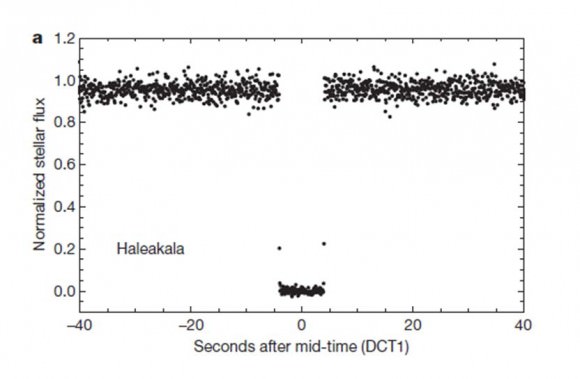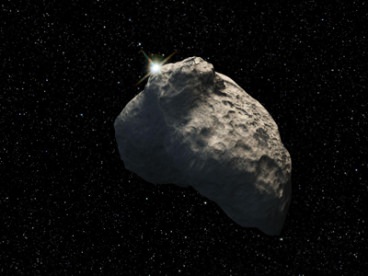[/caption]
How do you study an extremely small planetary body in the dim outer reaches of our solar system? Get all your friends from around the world to wait for a very elusive – if not short-lived – special event. And in doing so, you may find something completely unexpected. Enter James Elliot from MIT, who worked with dozens of observatories and astronomers across the globe, including Jay Pasachoff from Williams College in Massachusetts, in an attempt to make observations of the Kuiper Belt Object 55636, (also known as 2002 TX300) a small body orbiting about 48 AU away from the Sun. Since this KBO is too small and distant for direct observations of its surface, the astronomers tracked and plotted its course, figuring out when it would pass in front of a distant star.
The KBO occulted, or passed in front of a bright background star, an event which lasted only 10 seconds. But in that short amount of time, the astronomers were able to determine the object’s size and albedo. Both of these results were surprising.
55636 was found to be smaller than previously thought, 300km in diameter, but it is highly reflective, meaning it is covered in fresh, white ice.
Most known KBOs have dark surfaces due to space weathering, dust accumulation and bombardment by cosmic rays, so 55636’s brightness implies it has an active resurfacing mechanism, or perhaps that in some cases, fresh water ice can persist for billions of years in the outer reaches of the Solar System.

42 astronomers from 18 observatories located in Australia, New Zealand, South Africa, Mexico and the US were part of the observations, but because of weather and timing, only two observatories, both in Hawaii, were able to detect the occultation. Working with Wayne Rosing, Pasachoff coordinated the observations at the Las Cumbres Observatory Global Telescope Network located at Haleakala Crater on Maui, Hawaii, which made the best observations.
But Pasachoff told Universe Today that having two different angles of view to work with provided the ability to make quite precise measurements of the KBO.
“It was absolutely crucial to have the second observation site,” he said. “Without it, we
would not have known where on a round or elliptical body the chord, the line of occultation, passed and we could not have set an upper limit to the size of the body.”
A chord near the edge of a huge body can be vanishingly small, Pasachoff added, illustrating why they needed at least two chords.
Although the surfaces of other highly reflective bodies in the solar system, such as the dwarf planet Pluto and Saturn’s moon Enceladus, are continuously renewed with fresh ice from the condensation of atmospheric gases or by cryovolcanism that spews water instead of lava, 55636 is too small for these mechanisms to be at work.
“The surprising thing in a billion-year-old object that is so reflective is that it maintained or renewed its reflectivity,” said Pasachoff, “so possibilities include the darkening that we know takes place in the inner solar system is much less way out there; or the object renews its ice or frost from inside. We need new observations or more KBO’s with occultations, and we need more theoretical work.”
This was the first successful “planned” observation of a KBO using the stellar occultation method. In 2009 another team scoured through four and a half years of Hubble data to find on occultation of an extremely small KBO 975 meters (3,200 feet) across and a whopping 6.7 billion kilometers (4.2 billion miles) away.
For several years, Pasachoff and his team from Williams College have worked with Elliot and others from MIT, as well as Amanda Gulbis of the South African Astronomical Observatory to study Pluto by occultation. With careful measurements of a star’s brightness as Pluto hides or occults it, they have shown that Pluto’s atmosphere was slightly warming or expanding. A main goal now is to find out how the atmosphere is changing. This will be especially significant with the New Horizons spacecraft en route to Pluto.
Pasachoff said he knew 55636’s albedo would be bright, but was surprised how bright it was. The origins of this object is believed to come from a collision that occurred one billion years ago between one of the three known dwarf planets in the Kuiper Belt, Haumea and another object that caused Haumea’s icy mantle to break into a dozen or so smaller bodies, including 55636.
“Mike Brown (KBO and dwarf planet hunter from Caltech) told me last year, before the observations, that the object would be reflective since it is in the Haumea family, and Haumea itself has a high albedo,” Pasachoff said.
Pasachoff worked with Brown and his team last year in trying to capture the mutual occultations of transits of Haumea with its moon Namaka using the Palomar 5-meter telescope, but they weren’t successful in detecting the extremely small effect, given Haumea’s rapid rotation period.
Elliot used the occultation method to discover the rings of Uranus decades ago and continues to champion the method.
Pasachoff said the recent observation of 55636 was very rewarding. “It was an incredible observation, and I was very pleased to be part of it.” He said. “I am proud that all three of the graphs in the Nature article, and both of the successful observations, were arranged or made by our Williams College team.”
He added that any such observation includes at least these four elements: astrometric predictions, observations, reduction of data, interpretation.
“We were very fortunate and interested in being successful with observations,” Pasachoff said. “But it is important to note that Jim Elliot and his colleagues at MIT and Lowell Observatory have been working for years to refine the methods of predictions to get them accurate enough for this purpose. And this event was the first time that the predictions had been accurate enough to merit the all-out press of telescopes that we assembled. That we picked up the event, near the center of the prediction to boot, is a credit to the astrometry team.”
Note: This article was updated on 6/20.
The team’s paper was published in the journal Nature.
Sources: Williams College,(and email exchange with Jay Pasachoff), MIT, BBC, Nature


55636, originally carried the designation 2002 TX300, is a member of the Haumea collisional family. The objects have spectra similar to Haumea and are expected, at least by Dr. Brown, to have similar albedo.
Couple of typos: in paragraph 5 and 8, 55363 should be 55636.
Hmm… perhaps there has been a more recent collision?
How big is the KBO?
@RUF:
300km in diameter, as stated in the third paragraph of the article.